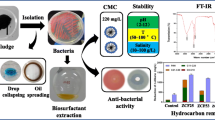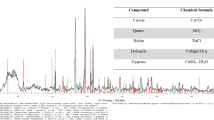Abstract
With the frequent occurrence of oil spills, the bioremediation of petroleum hydrocarbons pollution has attracted more and more attention. In this study, we investigated the biodegradation of crude oil by the biosurfactant-producing strain S-1. The strain was isolated from petroleum-contaminated soil and identified as Serratia marcescens according to partial 16S rDNA gene analysis. It was able to effectively degrade hydrocarbons with the concomitant production of biosurfactants at 20–30 °C, while there was no biosurfactant production and the degradation rate was lower at 37 °C. The biosurfactant was identified as serrawettin W1 by UPLC-ESI–MS, and was found to reduce the surface tension of water to 30 mN/m, with stable surface activity and emulsion activity at temperatures from 20 to 100 °C, pH of 2–10 and NaCl concentrations of 0–50 g/L. Serrawettin W1 significantly increased the cell surface hydrophobicity (CSH) and enhanced the bioavailability of hydrocarbon pollutants, which was conducive to the degradation of crude oil, including long-chain alkanes and aromatic hydrocarbons. Serratia marcescens S-1 has potential applications in bioremediation at low temperature.
Graphic abstract







Similar content being viewed by others
References
Suja F, Rahim F, Taha MR, Hambali N, Razali MR, Khalid A, Hamzah A (2014) Effects of local microbial bioaugmentation and biostimulation on the bioremediation of total petroleum hydrocarbons (TPH) in crude oil contaminated soil based on laboratory and field observations. Intern Biodeterior Biodegrad 90:115
Roberts ER (2019) Remediation of petroleum contaminated soils: biological, physical, and chemical processes. CRC Press
Zhao D, Liu C, Liu L, Zhang Y, Liu Q, Wu W-M (2011) Selection of functional consortium for crude oil-contaminated soil remediation. Intern Biodeterior Biodegrad 65:1244
Parthipan P, Preetham E, Machuca LL, Rahman PK, Murugan K, Rajasekar A (2017) Biosurfactant and degradative enzymes mediated crude oil degradation by bacterium Bacillus subtilis A1. Front Microbiol. https://doi.org/10.3389/fmicb.2017.00193
Abena MTB, Sodbaatar N, Li T, Damdinsuren N, Choidash B, Zhong W (2019) Crude oil biodegradation by newly isolated bacterial strains and their consortium under soil microcosm experiment. Appl Biochem Biotechnol 189:1223
**a M, Liu Y, Taylor AA, Fu D, Khan AR, Terry N (2017) Crude oil depletion by bacterial strains isolated from a petroleum hydrocarbon impacted solid waste management site in California. Intern Biodeterior Biodegrad 123:70
Varjani SJ (2017) Microbial degradation of petroleum hydrocarbons. Bioresour Technol 223:277
Hentati D, Chebbi A, Mahmoudi A, Hadrich F, Chamkha M (2020) Biodegradation of hydrocarbons and biosurfactants production by a newly halotolerant Pseudomonas sp. strain isolated from contaminated seawater. Biochem Eng J 166:107861
Tao W, Lin J, Wang W, Huang H, Li S (2020) Biodegradation of aliphatic and polycyclic aromatic hydrocarbons by the thermophilic bioemulsifier-producing Aeribacillus pallidus strain SL-1. Ecotoxicol Environ Saf 189:109994
Deng Z, Jiang Y, Chen K, Gao F, Liu X (2020) Petroleum depletion property and microbial community shift after bioremediation Using Bacillus halotolerans T-04 and Bacillus cereus 1–1. Front Microbiol. https://doi.org/10.3389/fmicb.2020.00353
de Souza MM, Colla TS, Bücker F, Ferrão MF, Te Huang C, Andreazza R, de Oliveira Camargo FA, Bento FM (2016) Biodegradation potential of Serratia marcescens for diesel/biodiesel blends Int Biodeterior. Biodegradation 110(141):146
Aruldass CA, Venil CK, Zakaria ZA, Ahmad WA (2014) Brown sugar as a low-cost medium for the production of prodigiosin by locally isolated Serratia marcescens UTM1. Intern Biodeter Biodegrad 95:19
Clements T, Ndlovu T, Khan S, Khan W (2019) Biosurfactants produced by Serratia species: classification, biosynthesis, production and application. Appl Microbiol Biotechnol 103:589
Matsuyama T, Murakami T, Fujita M, Fujita S, Yano I (1986) Extracellular vesicle formation and biosurfactant production by Serratia marcescens. J Gen Microbiol 132:865
Nalini S, Parthasarathi R (2013) Biosurfactant production by Serratia rubidaea SNAU02 isolated from hydrocarbon contaminated soil and its physico-chemical characterization. Bioresour Technol 147:619
Pruthi V, Cameotra SS (2000) Novel sucrose lipid produced by Serratia marcescens and its application in enhanced oil recovery. J Surfactants Deterg 3:533
Bidlan R, Deepthi N, Rastogi NK, Manonmani HK (2007) Optimised production of biosurfactant by Serratia marcescens DT-1P. Res J Microbiol 2:705–716
Matsuyama T, Fujita M, Yano I (1985) Wetting agent produced by Serratia marcescens. FEMS Microbiol Lett 28:125
Matsuyama T, Sogawa M, Nakagawa Y (1989) Fractal spreading growth of Serratia marcescens which produces surface active exolipids. FEMS Microbiol Lett 52:243
Rosenberg M, Gutnick D, Rosenberg E (1980) Adherence of bacteria to hydrocarbons: a simple method for measuring cell-surface hydrophobicity. FEMS Microbiol Lett 9:29
Wang D, Lin J, Lin J, Wang W, Li S (2019) Biodegradation of petroleum hydrocarbons by Bacillus subtilis BL-27, a strain with weak hydrophobicity. Molecules 24:3021
Shanks RMQ, Lahr RM, Stella NA, Arena KE, Brothers KM, Kwak DH, Liu X, Kalivoda EJ (2013) A Serratia marcescens pigp homolog controls prodigiosin biosynthesis, swarming motility and hemolysis and is regulated by cAMP-CRP and HexS. PloS One 8:e57634
Liu Q, Lin J, Wang W, Huang H, Li S (2015) Production of surfactin isoforms by Bacillus subtilis BS-37 and its applicability to enhanced oil recovery under laboratory conditions. Biochem Eng J 93:31
Fan Y, Tao W, Huang H, Li S (2017) Characterization of a novel bioemulsifier from Pseudomonas stutzeri. World J Microbiol Biotechnol. https://doi.org/10.1007/s11274-017-2326-2
**a M, Fu D, Chakraborty R, Singh RP, Terry N (2019) Enhanced crude oil depletion by constructed bacterial consortium comprising bioemulsifier producer and petroleum hydrocarbon degraders. Bioresour Technol 282:456
Matsuyama T, Tanikawa T, Nakagawa Y (2011) Serrawettins and other surfactants produced by Serratia. Springer, Berlin
Takashi N, Taichiro T, Hiroyuki H, Chihiro T, Yumi A, Mitsugu M, Yoji N, Tohey M (2007) Rhamnolipid-dependent spreading growth of Pseudomonas aeruginosa on a high-agar medium: marked enhancement under CO2-rich anaerobic conditions. Microbiol Immunol 51:703
Liu S, Zou Y, Chang F, Chen F, Cao Y (2018) Isolation and identification of Serratia marcescens producing high levels of prodigiosin and its fermentation optimization. Chin J App Environ Biol 24:26–32
Wei YH, Chen WC (2005) Enhanced production of prodigiosin-like pigment from Serratia marcescens SMdeltaR by medium improvement and oil-supplementation strategies. J Biosci Bioeng 99:616–622
Zhu Z, Zhang B, Cai Q, Ling J, Chen B (2020) Fish waste based lipopeptide production and the potential application as a bio-dispersant for oil spill control. Front Bioeng Biotechnol 8:734
Thavasi R, Sharma S, Jayalakshmi S (2011) Evaluation of screening methods for the isolation of biosurfactant producing marine bacteria. Pet Environ Biotechnol. https://doi.org/10.4172/2157-7463.S1-001
Abbasnezhad H, Gray MR, Foght JM (2008) Two different mechanisms for adhesion of Gram-negative bacterium, Pseudomonas fluorescens LP6a, to an oil-water interface. Colloids Surf B: Biointerfaces 62:36
Chen Z, Le J, Shenghui W, Jie Q, Kang L, Lili X, Yanhua S, Yanchun Y (2010) Biodegradation of beta-cypermethrin by two Serratia spp with different cell surface hydrophobicity. Bioresour Technol 101:3423
Sonja K, Alexander B, Nadine K, Karl-Erich J, Anita L, Stephan T (2019) Marine biosurfactants: biosynthesis, structural diversity and biotechnological applications. Mar drugs 17:408
Wongsa P, Tanaka M, Ueno A, Hasanuzzaman M, Yumoto I, Okuyama H (2004) Isolation and characterization of novel strains of Pseudomonas aeruginosa and Serratia marcescens possessing high efficiency to degrade gasoline, kerosene, diesel oil, and lubricating oil. Curr Microbiol 49:415
Morales-Guzmán G, Ferrera-Cerrato R, Rivera-Cruz MdC, Torres-Bustillos LG, Arteaga-Garibay RI, Mendoza-López MR, Esquivel-Cote R, Alarcón A (2017) Diesel degradation by emulsifying bacteria isolated from soils polluted with weathered petroleum hydrocarbons. Appl Soil Ecol 121:127
Dennis E, Michael S, Souvik K (2018) Spatial-temporal profiling of prodiginines and serratamolides produced by endophytic Serratia marcescens harbored in Maytenus serrata. Sci Rep. https://doi.org/10.1038/s41598-018-23538-5
Su C, **ang Z, Liu Y, Zhao X, Sun Y, Li Z, Li L, Chang F, Chen T, Wen X, Zhou Y, Zhao F (2016) Analysis of the genomic sequences and metabolites of Serratia surfactantfaciens sp. nov. YD25T that simultaneously produces prodigiosin and serrawettin W2. BMC Genomics 17:1
Stephan T, Beatrix S-S, Filip K, Frank R, Rudolf H, Karl-Erich J (2014) Heterologous production of the lipopeptide biosurfactant serrawettin W1 in Escherichia coli. J Biotechnol 181:27
Soberón-Chávez Gloria (2011) Biosurfactants: a general overview. Springer, Berlin
Inès M, Dhouha G (2015) Review lipopeptides biosurfactants: mean classes and new insights for industrial, biomedical, and environmental applications. Biopolymers 104:129
Wei YH, Lai HC, Chen SY, Yeh MS, Chang JS (2004) Biosurfactant production by Serratia marcescens SS-1 and its isogenic strain SMΔR defective in SpnR, a quorum-sensing LuxR family protein. Biotech Lett 26:799–802
Kan Kung-Hao (2006) Production and characterization of a lipopeptide biosurfactant-serrawettin from Serratia marcescens SM△R. Master Thesis, Yuan Ze University, Chungli, China, Taiwan (in chinese)
Liu G, Hua Z, **n Y, Yang L, Shao B, Liu Z (2018) Advances in applications of rhamnolipids biosurfactant in environmental remediation: a review. Biotechnol Bioeng 115:796
White DA, Hird LC, Ali ST (2013) Production and characterization of a trehalolipid biosurfactant produced by the novel marine bacterium Rhodococcus sp., strain PML026. J Appl Microbiol 115:744
Bao Q, Huang L, **u J, Yi L, Ma Y (2021) Study on the treatment of oily sludge in oil fields with lipopeptide/sophorolipid complex bio-surfactant. Ecotoxicol Environ Saf 212:111964
Funding
This work was supported by the National Natural Science Foundation of China (No. 51774188); and the Jiangsu Synergetic Innovation Center for Advanced Bio-Manufacture.
Author information
Authors and Affiliations
Corresponding author
Ethics declarations
Conflict of interest
All authors certify that they have no affiliations with or involvement in any organization or entity with any financial interest or non-financial interest in the subject matter or materials discussed in this manuscript.
Additional information
Publisher's Note
Springer Nature remains neutral with regard to jurisdictional claims in published maps and institutional affiliations.
Supplementary Information
Below is the link to the electronic supplementary material.
Rights and permissions
About this article
Cite this article
Zhang, K., Tao, W., Lin, J. et al. Production of the biosurfactant serrawettin W1 by Serratia marcescens S-1 improves hydrocarbon degradation. Bioprocess Biosyst Eng 44, 2541–2552 (2021). https://doi.org/10.1007/s00449-021-02625-4
Received:
Accepted:
Published:
Issue Date:
DOI: https://doi.org/10.1007/s00449-021-02625-4




